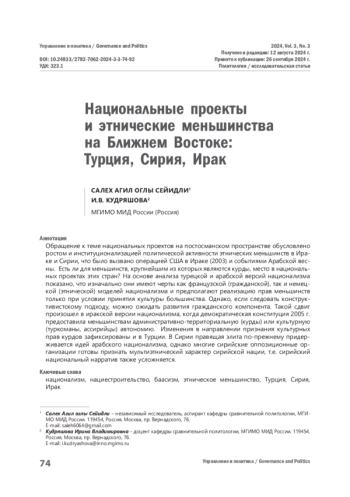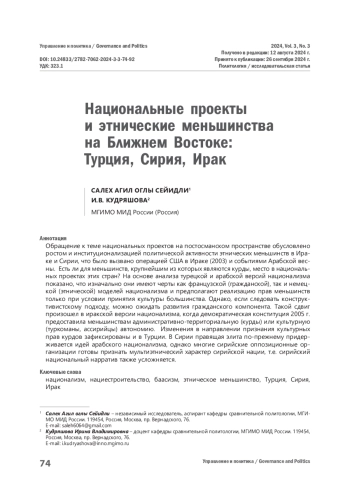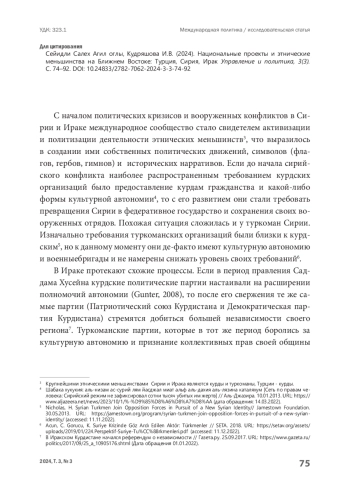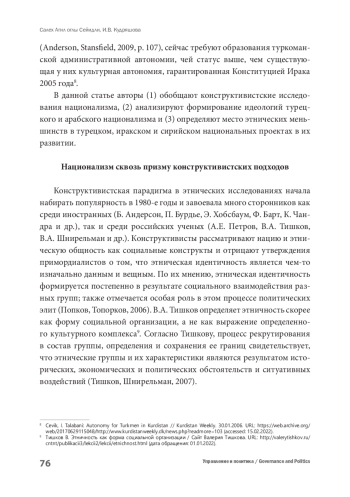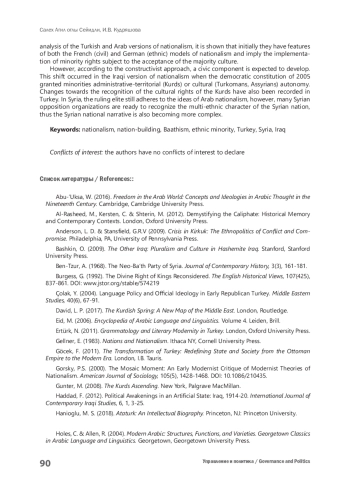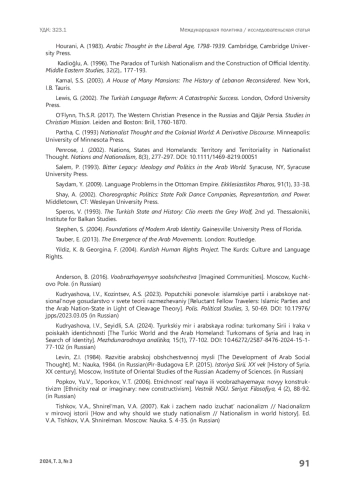1. Abu-’Uksa, W. (2016). Freedom in the Arab World: Concepts and Ideologies in Arabic Thought in the Nineteenth Century. Cambridge, Cambridge University Press.
2. Al-Rasheed, M., Kersten, C. & Shterin, M. (2012). Demystifying the Caliphate: Historical Memory and Contemporary Contexts. London, Oxford University Press.
3. Anderson, L. D. & Stansfield, G.R.V (2009). Crisis in Kirkuk: The Ethnopolitics of Conflict and Compromise. Philadelphia, PA, University of Pennsylvania Press.
4. Bashkin, O. (2009). The Other Iraq: Pluralism and Culture in Hashemite Iraq. Stanford, Stanford University Press.
5. Ben-Tzur, A. (1968). The Neo-Ba’th Party of Syria. Journal of Contemporary History, 3(3), 161-181. Burgess, G. (1992). The Divine Right of Kings Reconsidered. The English Historical Views, 107(425), 837-861. https://doi.org/www.jstor.org/stable/574219
6. Çolak, Y. (2004). Language Policy and Official Ideology in Early Republican Turkey. Middle Eastern Studies, 40(6), 67-91.
7. David, L. P. (2017). The Kurdish Spring: A New Map of the Middle East. London, Routledge. Eid, M. (2006). Encyclopedia of Arabic Language and Linguistics. Volume 4. Leiden, Brill.
8. Ertürk, N. (2011). Grammatology and Literary Modernity in Turkey. London, Oxford University Press. Gellner, E. (1983). Nations and Nationalism. Ithaca NY, Cornell University Press.
9. Göcek, F. (2011). The Transformation of Turkey: Redefining State and Society from the Ottoman Empire to the Modern Era. London, I.B. Tauris.
10. Gorsky, P.S. (2000). The Mosaic Moment: An Early Modernist Critique of Modernist Theories of Nationalism. American Journal of Sociology, 105(5), 1428-1468. https://doi.org/10.1086/210435.
11. Gunter, M. (2008). The Kurds Ascending. New York, Palgrave MacMillan.
12. Haddad, F. (2012). Political Awakenings in an Artificial State: Iraq, 1914-20. International Journal of Contemporary Iraqi Studies, 6, 1, 3-25.
13. Hanioglu, M. S. (2018). Ataturk: An Intellectual Biography. Princeton, NJ: Princeton University.
14. Holes, C. & Allen, R. (2004). Modern Arabic: Structures, Functions, and Varieties. Georgetown Classics in Arabic Language and Linguistics. Georgetown, Georgetown University Press.
15. Hourani, A. (1983). Arabic Thought in the Liberal Age, 1798-1939. Cambridge, Cambridge University Press.
16. Kadioğlu, A. (1996). The Paradox of Turkish Nationalism and the Construction of Official Identity. Middle Eastern Studies, 32(2),. 177-193.
17. Kamal, S.S. (2003). A House of Many Mansions: The History of Lebanon Reconsidered. New York, I.B. Tauris.
18. Lewis, G. (2002). The Turkish Language Reform: A Catastrophic Success. London, Oxford University Press.
19. O’Flynn, Th.S.R. (2017). The Western Christian Presence in the Russias and Qājār Persia. Studies in Christian Mission. Leiden and Boston: Brill, 1760-1870.
20. Partha, C. (1993) Nationalist Thought and the Colonial World: A Derivative Discourse. Minneapolis: University of Minnesota Press.
21. Penrose, J. (2002). Nations, States and Homelands: Territory and Territoriality in Nationalist Thought. Nations and Nationalism, 8(3), 277-297. https://doi.org/10.1111/1469-8219.00051
22. Salem, P. (1993). Bitter Legacy: Ideology and Politics in the Arab World. Syracuse, NY, Syracuse University Press.
23. Saydam, Y. (2009). Language Problems in the Ottoman Empire. Ekklesiastikos Pharos, 91(1), 33-38. Shay, A. (2002). Choreographic Politics: State Folk Dance Companies, Representation, and Power. Middletown, CT: Wesleyan University Press.
24. Speros, V. (1993). The Turkish State and History: Clio meets the Grey Wolf, 2nd уd. Thessaloniki, Institute for Balkan Studies.
25. Stephen, S. (2004). Foundations of Modern Arab Identity. Gainesville: University Press of Florida. Tauber, E. (2013). The Emergence of the Arab Movements. London: Routledge.
26. Yildiz, K. & Georgina, F. (2004). Kurdish Human Rights Project. The Kurds: Culture and Language Rights.
27. Андерсон Б. (2016). Воображаемые сообщества. М., Кучково поле.
28. Кудряшова И.В., Козинцев А.С. (2023). Попутчики поневоле: исламские партии и арабское национальное государство в свете теории размежеваний. Полис. Политические исследования. № 3. C. 50-69. https://doi.org/10.17976/jpps/2023.03.05
29. Кудряшова И.В., Сейидли С.А. (2024). Тюркский мир и арабская родина: туркоманы Сирии и Ирака в поисках идентичности. Международная аналитика. № 15(1). C. 77-102. https://doi.org/10.46272/2587-8476-2024-15-1-77-102
30. Левин З.И. (1984). Развитие арабской общественной мысли. М.: Наука, 1984.
31. Пир-Будагова Э.П. (2015). История Сирии. XX век. М., ИВ РАН.
32. Попков Ю.В., Топорков В.Т. (2006). Этничность реальная или воображаемая: новый конструктивизм. Вестник НГУ. Серия: Философия. № 4 (2). C. 88-92.
33. Тишков В.А., Шнирельман В.А. (2007). Как и зачем надо изучать национализм // Национализм в мировой истории. Отв. ред. В.А. Тишков, В.А. Шнирельман. М.: Наука. С. 4-35.
34. Аль-Мардини, З. (1988). Кысса аль-хаят Мишель Афляк. Бейрут, Рияд аль-рис лиль-китаб ва ан-нашр. (in Arabic)
35. Битар, С. (1960). Ас-сияса аль-арабийа байн аль-мабда ва ат-татбик (Арабская политика в принципах и на практике). Бейрут, Дар аль-Талия. (in Arabic)
